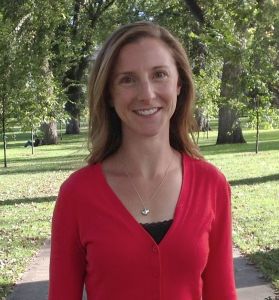
To say Bailey Fosdick’s latest scientific paper is causing a stir would be an understatement.
The CSU statistics professor helped develop a new model for the United Nations that projects the Earth’s population will increase by 2100 – not level off as many demographers have predicted.
Fosdick worked on the statistical model as a graduate student at the University of Washington, and co-authored a paper about the project, which recently appeared in the journal Science. 
Since then, the model – and its predictions – have made headlines around the world and ignited discussion among the scientific community about the team’s methods.
“The article has sparked some great scholarly debate,” said Fosdick, who recently joined the Department of Statistics in the College of Natural Sciences.
That’s because the model is based on far different methods than in the past.
Led by University of Washington professor Adrian Raftery, the team developed statistical equations based on 60 years of data on worldwide birth and death rates and migration patterns.
Past United Nations population studies relied on experts’ opinions on whether death and birth rates in different parts of the world would increase or decrease in the future.
Based on that historical data, the new model predicts the planet’s population will reach between 9.6 and 12.3 billion by 2100.
We sat down with Fosdick and asked her a few questions.
Why is the model causing so much debate?
In any forecasting model for world population, assumptions must be made about the future temporal structure of fertility, mortality and migration, i.e. how these quantities will change over time. Historically, decisions about future trajectories of these vital rates were heavily influenced by the opinions of experts.
While experts have valuable knowledge about a country’s past and potentially near future, the methods we propose move away from expert-based projections to more mathematically formal, probability-based models, which extract patterns from past vital rate records and incorporate these patterns future rate projections. Since the same modeling framework is used for each country, our approach is not subject to the expert-to-expert variability and bias that was likely present in previous projection approaches.
To predict future demographic rates for a country, our model leverages historical rate information across all countries and recent vital rate trajectories for the specific country. For example, historical records show that as countries become more developed, they undergo a fertility decline. The shape of this decline is common across almost all countries that have undergone the transition.
However, as noted in the paper, the current rate of decline for many African countries is about one-quarter of the rate at which Asia and Latin America fertility declined during their demographic transitions in the 1970s. For this reason, in our projections we estimate the shape of the fertility decline for African countries will mimic that of other countries’, yet based on the recent declines, will likely occur at a much slower rate than seen previously.
Did you think this would be the response?
Any time a new method is proposed in science that differs drastically from the norm, there is likely to be thorough evaluation by all researchers in the relevant fields. It is this discussion and peer-review that sparks further innovation and encourages continual knowledge growth in the field. Researchers challenging one-another’s ideas is a healthy process and benefits science as a whole, so while the level of the debate may have exceeded my expectations, I understand and support that it has occurred.
What was your role in developing the model?
My contribution to the project was developing methods to accurately quantify the uncertainty in fertility rate forecasts for all countries in the world. This work was joint with Adrian Raftery and is described in detail in the 2014 Demographic Research article titled “Regional Probabilistic Fertility Forecasting by Modeling Between-country Correlations”.
In our work, we estimated the dependence between country fertility rates to understand if countries’ fertility rates are correlated, and if so, which ones.
For instance, by examining whether or not Mali’s and Bukina Faso’s fertility rates are correlated, we can determine if we should expect Mali’s fertility rate to decline in the future if Bukina Faso’s fertility rate declines. Thorough understanding of these dependencies enables us to better estimate the uncertainty of future fertility levels across the world.
Population forecasts are obtained by combining fertility forecasts with mortality and migration forecasts. Therefore, understanding uncertainty in fertility rate forecasts is a key component to understanding uncertainty in world population forecasts.
Will you continue to work on this at CSU?
I may continue work on applications of statistical methods in demography.
However, much of my current research is focused on the development of statistical methodology for analyzing social networks. The social networks I research range from adolescent friendship networks to dynamic baboon grooming networks.
Network science spans numerous disciplines so realistic models for networks which are grounded in probability theory are in high demand and of great importance in many fields.